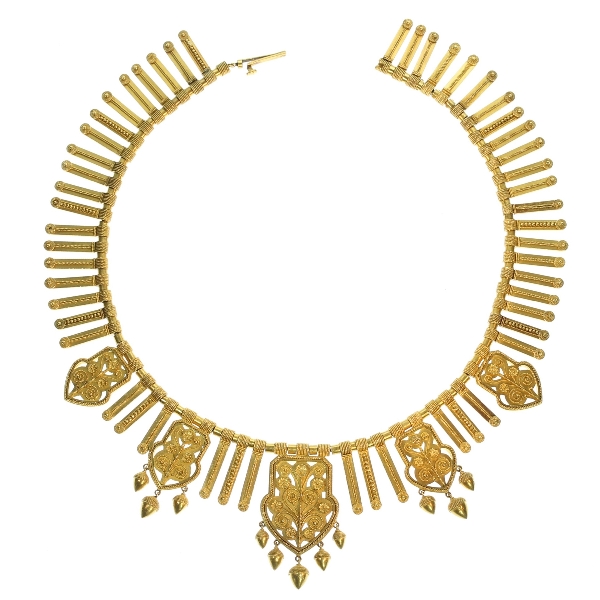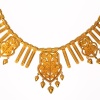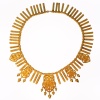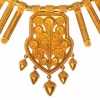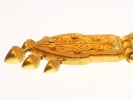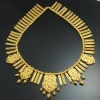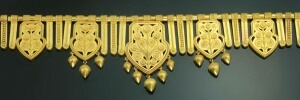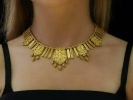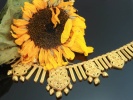We offer layaway, spread payments on the piece of your dreams. Ask us for details. Free insured shipping on all orders !!!
Antique gold filigree choker necklace made in France
Undeniably a breathtaking 18k antique yellow gold French Filigree Choker Necklace that showcases the incomparable granulation technique whereby gold wires are masterfully twisted into delicate shapes and filigree reminiscent of a bygone ancient era! Immense skill & precision is clearly evident within the uniformly beaded fringe, stunning florettes and intricate wirework. Thisstriking collar necklace is in very good condition – circa 1870 – length: 36.50 cm (14.37 inch) – Weight: 84.50 grams. A stunning eye catcher worn separately or showcased amongst other pieces!
The continuous uniform fringe decorated with beads, wirework and florettes of this necklace is typical for the work of Eugène Fontenay. A demi-parure of very similar design is illustrated in French Jewelry of the Nineteenth Century, Henri Vever, translated by Katherine Purcell, p. 643. and a similar necklace plus matching earrings were sold at Sotheby's for $ 52,000 (Important Jewels auction, New York, February 2008 sale N08410, lot 110).
Eugène Fontenay (1823-87) was one of the foremost goldsmiths in France during the second half of the nineteenth century. He was a great admirer of the ancient techniques of granulation and filigree, and became best known for his outstanding work in the 'archaeological' style. Fontenay was no doubt inspired by the Campana collection of ancient jewellery, acquired by Napoleon III in 1860, and his firm produced much work in the antique style based on Greek, Roman and Etruscan examples.
Eugène Fontenay, son of goldsmith Prosper Fontenay, founded his own workshop on the rue Favart, Paris, in 1847. By the 1850s he had achieved considerable success, culminating in the execution of a tiara for the Empress Eugènie in 1858. However, it is his work of the 1860s for which he is most renowned. Called the "archeological style," Fontenay's pieces were influenced by ancient Greek, Roman, and Etruscan examples, and were certainly inspired by the 1860 arrival in Paris of the Campana Collection, ancient jewelry purchased by Napoleon III. In addition to exquisite goldwork, Fontenay collaborated with the enamelist Eugène Richet on a series of jewelry containing enameled plaques which employed antique themes and an antique style. He received a gold medal at the 1867 Paris World Exhibition for his work in this style, and counted among his many prominent clients the Viceroy of Egypt, the Shah of Persia and the King of Siam.
Fontenay was a founding member of the Chambre Syndicale de la Bijouterie-Joaillerie-Orfèvrerie in Paris and was awarded the cross of the Légion d'Honneur as a member of the jury at the Vienna exhibition in 1873 as a result of his masterly Report on the goldsmiths' and silversmiths' work. In 1882, Fontenay retired and devoted his time to publishing numerous articles on jewelry, as well as working on his masterpiece, Les Bijoux Anciens et Modernes, published posthumously in 1887.
Henri Vever in his extensive work French Jewelry of the 19th Century, described Fontenay as a "man of distinction and rare intelligence, of great discernment and impeccable taste. A true artist and a distinguished writer, he handled a pen as skilfully as a paint brush." See also the Vever, p. 642.
Antique jewelry object group: necklaces
Country of origin: France
Style: Victorian
(more info on styles)
Style specifics: Archeological revival
Neo Etruscan
More style info: The archaeological revival is the appellation for neo-styles of the 18th and 19th centuries that where inspired by discoveries in the excavations of Roman, Egyptian, Hellenistic and Etruscan sites. The
first revival in the 18th century, which is called neoclassicism, came after excavations of the cities of Pompeii and Herculaneum. The second revival was inspired by finds in Etruscan burial sites (in
Italy). In jewelry this style is characterized by granulation and filigree decorations. There is some discussion among experts on who rediscovered the granulation technique. To some it was Castellani
in the 19th Century but various methods of manufacturing and handling of granules have been described by Pliny in 79 AD, V. Biringucchio in 1540, G. Agricola in 1556, B. Cellini in 1568, M. Fachs in
1595 and A. Libavius in 1597/1606.
Period: ca. 1870
(events and facts in 1870)
Source of inspiration: Etruscans
Material: 18K yellow gold
(more info on precious metals)
Technique: This jewel features a filigree decoration, which is in fact thin gold wire twisted into refined motifs, in this case elegant little
balls. You can also notice the use of granulation on this piece. Granulation is a technique where the goldsmith uses very small balls (granules) of metal, which are not
soldered to the piece but welded. Both techniques demand very high skills and precision from the maker.
Hallmarks: The French control mark for 18K gold representing an
eagle's head (that was in use in France from
about 1838) and remains of other marks.
(more info on hallmarks)
Condition: very good condition
(more info on our condition scale)
Dimensions: length necklace 36.50 cm (14.37 inch)
Weight: 84.50 gram (54.33 dwt)
Reference Nº: 09251-0188
See also our:
victorian jewelry,
victorian necklaces,
necklaces,
neo-etruscan jewelry,
neo-egyptian jewelry,
jewelry with filigree & granules,
latest acquisitions,
antique jewelry,
estate jewelry,
vintage jewelry or
modern jewelry
Jewelry with birthstones (or month stones) for:
January -
February -
March -
April -
May -
June -
July
August -
September -
October -
November or
December.
Additional information:
jewelry glossary -
wall of fame -
visit us in Antwerp -
subscribe to our mailinglist.
What is antique jewelry? -
What is estate jewelry? -
What is vintage jewelry?



